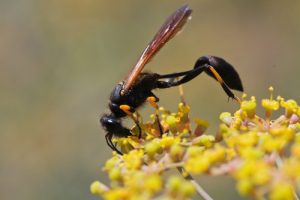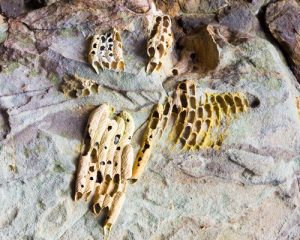Mud Dauber Wasps
By Chris Williams on April 21, 2011.
Q. Do you know what those mud tubes are that I see on the wall under my front porch? Do they belong to some kind of insect? Some of the tubes have holes in them.
A. What you’re seeing are the nests of the mud dauber wasp, probably the organ pipe mud dauber. This wasp’s long mud tube nests are stacked side by side, looking like the pipes of an organ. In early spring, you’re probably seeing what is left of last year’s nests. The holes mean that the wasps have already exited the nest.
 Soon, however, you will likely see new mud dauber activity as wasps begin building their nests again. Mud daubers (sometimes called dirt daubers) are solitary wasps, not like yellowjackets and other social wasps that live together in a colony. But individual females often build new nests in the same locations where nests have been built before so your porch must be a desirable site. Although the wasps buzz loudly when busy making nests, they are not very aggressive and rarely sting. The entire nest building process doesn’t last long. Usually by the time you really notice the wasps, the nest is complete and the wasps are gone.
Soon, however, you will likely see new mud dauber activity as wasps begin building their nests again. Mud daubers (sometimes called dirt daubers) are solitary wasps, not like yellowjackets and other social wasps that live together in a colony. But individual females often build new nests in the same locations where nests have been built before so your porch must be a desirable site. Although the wasps buzz loudly when busy making nests, they are not very aggressive and rarely sting. The entire nest building process doesn’t last long. Usually by the time you really notice the wasps, the nest is complete and the wasps are gone.
Mud dauber nest construction is rather a fascinating thing. The female wasp gathers mud from pools and puddles. She bites off a piece, rolls it into a ball, and carries it in her jaws to the nest site. She constructs a series of mud cells, each one designed to be a miniature, self-contained nursery for her offspring. Then, the female captures and stings a spider to paralyze it. She then stuffs this meat supply into the cell, lays an egg on it, seals the cell with mud, and moves off to stock the next cell. When all the cells are stocked and sealed, she flies off to start another nest.
 The wasp larvae hatch in a few weeks and feed inside the mud tubes on the spiders that “mom” left them. When they’re fully developed, the larvae pupate and turn into adult wasps, chewing a round hole in the mud tube to exit. Any new adult mud daubers that emerge in summer mate and build their own nests. For mud dauber species that have two generations a year, this second group of larvae remain in their mud nests over the winter, emerging the following spring.
The wasp larvae hatch in a few weeks and feed inside the mud tubes on the spiders that “mom” left them. When they’re fully developed, the larvae pupate and turn into adult wasps, chewing a round hole in the mud tube to exit. Any new adult mud daubers that emerge in summer mate and build their own nests. For mud dauber species that have two generations a year, this second group of larvae remain in their mud nests over the winter, emerging the following spring.
So, the bottom line is that you don’t need to be too concerned about these wasps. They’re interesting, but admittedly their nests can be unsightly in highly visible locations. You can remove old mud dauber nests or even nests under construction with a putty knife. Then your children can have something for “show and tell” at school. You can usually see the individual cells with their spiders, and sometimes even the wasp larvae, exposed on the backside of the mud tubes